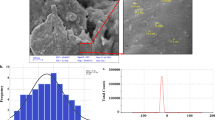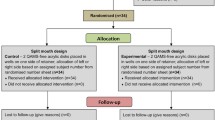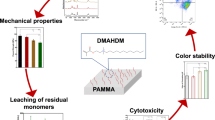Abstract
Polymethylmethacrylate (PMMA) acrylic resin is the most used material in dentistry for making prosthetic devices. The polymerization process can cause material failure, which favors the adhesion of microorganisms and reduces the properties of the acrylic resin in clinical practice. Therefore, the objective of this study was to carry out a systematic review in order to answer the question “What is the relation between porosity, wettability, sorption, and solubility properties of acrylic resins incorporated with antimicrobials?” The electronic search of the articles was carried out in four databases and articles published between 2012 and May 2022 were selected. The search terms were: ((“acrylic resin” OR PMMA OR polymethylmethacrylate OR methacrylate) AND (antimicrobial OR antifungal OR antibacterial OR nanoparticle) AND (porosity OR wettability OR “sorption and solubility” OR “microbial adesion”)). One thousand three hundred thirty articles were found in the databases, after removing the duplicates, 932 were analyzed by title and abstract, of these, 11 were selected for full reading, of which 06 met the inclusion criteria and were selected for review. After descriptive analysis, it can be concluded that acrylic resins incorporated with antimicrobials can maintain the ideal physicochemical properties for the clinical functioning of the material.



Similar content being viewed by others
References
Cascione M, De Matteis V, Pellegrino P et al (2021) Improvement of PMMA dental matrix performance by addition of titanium dioxide nanoparticles and clay nanotubes. Nanomaterials (Basel) 11:2027
Figuerôa RMS, Conterno B, Arrais CAG, Sugio CYC, Urban VM, Neppelenbroek KH (2018) Porosity, water sorption and solubility of denture base acrylic resins polymerized conventionally or in microwave. J Appl Oral Sci 26:e20170383
Kasina SP, Ajaz T, Attili S, Surapaneni H, Cherukuri M, Srinath HP (2014) To evaluate and compare the porosities in the acrylic mandibular denture bases processed by two different polymerization techniques, using two different brands of commercially available denture base resins - an in vitro study. J Int Oral Health 6:72–77
Kreve S, Dos Reis AC (2021) Bacterial adhesion to biomaterials: Whats regulates this attachment? A review Jpn Dent Sci Ver 57:85–96
Chladek G, Pakieła K, Pakieła W, Żmudzki J, Adamiak M, Krawczyk C (2019) Effect of antibacterial silver-releasing filler on the physicochemical properties of poly(methyl methacrylate) denture base material. Materials (Basel) 12:4146
Cucci AL, Vergani CE, Giampaolo ET, Afonso MC (1998) Water sorption, solubility, and bond strength of two autopolymerizing acrylic resins and one heat-polymerizing acrylic resin. J Prosthet Dent 80:434–438
Campos MR, Botelho AL, Dos Reis AC (2021) Nanostructured silver vanadate decorated with silver particles and their applicability in dental materials: a scope review. Heliyon 7:1–7
Castro DT, Holtz RD, Alves OL, Watanabe E, Valente ML, Silva CH, Reis AC (2014) Development of a novel resin with antimicrobial properties for dental application. J Appl Oral Sci 22:442–449
Ferreira I, Vidal CL, Botelho AL et al (2020) Effect of nanomaterial incorporation on the mechanical and microbiological properties of dental porcelain. J Prosthet Dent 123:529
Kreve S, Oliveira VC, Bachmann L, Alves OL, Reis ACD (2019) Influence of AgVO3 incorporation on antimicrobial properties, hardness, roughness and adhesion of a soft denture liner. Sci Rep 15(9):11889
Teixeira ABV, Vidal CL, de Castro DT, de Oliveira-Santos C, Schiavon MA, Dos Reis AC (2017) Incorporating antimicrobial nanomaterial and its effect on the antimicrobial activity, flow and radiopacity of endodontic sealers. Eur Endod J 2:1–6
Uehara LM, Ferreira I, Botelho AL, Valente MLDC, Reis ACD (2022) Influence of β-AgVO3 nanomaterial incorporation on mechanical and microbiological properties of dental porcelain. Dent Mater 38:e174–e180
Kartika UK, Agrawal B, Yadav NS, Singh PP, Rahangdale T (2015) The effect of microwave processing and use of antimicrobial agent on porosity of conventional heat cured denture base resin: an in vitro study. J Indian Prosthodont Soc 15:257–262
Maldonado VM, Acosta-Torres LS, Barcelo-Santana FH, Vanegas-Lancon RD, Plata-Rodríguez ME, Castaño VM (2012) Fiber-Reinforced nanopigmented poly(methylmethacrylate) as improved denture base. J Appl Polym Sci 26:289–296
Wady AF, Machado AL, Zucolotto V, Zamperini CA, Berni E, Vergani CE (2012) Evaluation of Candida albicans adhesion and biofilm formation on a denture base acrylic resin containing silver nanoparticles. J Appl Microbiol 112:1163–1172
Zidan S, Silikas N, Haider J, Yates J (2020) Long-Term Sorption and solubility of zirconia-impregnated pmma nanocomposite in water and artificial saliva. Materials (Basel) 13:3732
Moher D, Liberati A, Tetzlaff J, Altman DG (2010) Preferred reporting items for systematic reviews and meta-analysis: the PRISMA statement. Int J Surg 8:336–341
Castro DT, Valente ML, da Silva CH et al (2016) Evaluation of antibiofilm and mechanical properties of new nanocomposites based on acrylic resins and silver vanadate nanoparticles. Arch Oral Biol 67:46–53
Mai HN, Hong SH, Kim SH et al (2019) Effects of different finishing/polishing protocols and systems for monolithic zirconia on surface topography, phase transformation, and biofilm formation. J Adv Prosthodont 11:81–87
Compagnoni MA, Barbosa DB, de Souza RF, Pero AC (2004) The effect of polymerization cycles on porosity of microwave-processed denture base resin. J Prosthet Dent 91:281–285
Wolfaardt JF, Cleaton-Jones P, Fatti P (1986) The occurrence of porosity in a heat-cured poly (methyl methacrylate) denture base resin. J Prosthet Dent 55:393–400
Revised American Dental Association specification no (1975) 12 for Denture base polymers. J Am Dent Assoc 90:451–458
al Doori D, Huggett R, Bates JF, Brooks SC (1988) A comparison of denture base acrylic resins polymerised by microwave irradiation and by conventional water bath curing systems. Dent Mater 4:25–32
Altarawneh S, Bencharit S, Mendoza L, Curran A, Barrow D, Barros S, Preisser J, Loewy ZG, Gendreau L, Offenbacher S (2013) Clinical and histological findings of denture stomatitis as related to intraoral colonization patterns of Candida albicans, salivary flow, and dry mouth. J Prosthodont 22:13–22
Huhtamäki T, Tian X, Korhonen JT, Ras RHA (2018) Surface-wetting characterization using contact-angle measurements. Nat Protoc 13:1521–1538
Gad MM, Abualsaud R, Khan SQ (2022) Hydrophobicity of denture base resins: a systematic review and meta-analysis. J Int Soc Prev Commun Dent 12:139–159
Yoshijima Y, Murakami K, Kayama S, Liu D, Hirota K, Ichikawa T et al (2010) Effect of substrate surface hydrophobicity on the adherence of yeast and hyphal Candida. Mycoses 53:221–226
Casemiro LA, Gomes Martins CH, Pires-de-Souza Fde C, Panzeri H (2008) Antimicrobial and mechanical properties of acrylic resins with incorporated silver-zinc zeolite - part I. Gerodontology 25:187–194
Bacali C, Badea M, Moldovan M, Sarosi C, Nastase V, Baldea I, Chiorean RS, Constantiniuc M (2019) The influence of graphene in improvement of physico-mechanical properties in PMMA denture base resins. Materials (Basel) 23(12):2335
Funding
This research did not receive any specific grant from funding agencies in the public, commercial, or not-for-profit sectors.
Author information
Authors and Affiliations
Corresponding author
Ethics declarations
Conflict of interest
The authors declare no conflicts of interest.
Additional information
Publisher's Note
Springer Nature remains neutral with regard to jurisdictional claims in published maps and institutional affiliations.
Appendix 1: Database search strategy
Appendix 1: Database search strategy
Database | Search | Found |
|---|---|---|
PubMed Aug 03th, 2022 | ((“acrylic resin" OR PMMA OR polymethylmetacrylate OR methacrylate) AND (antimicrobial OR antifungal OR antibacterial OR nanoparticle) AND (porosity OR porous OR wettability OR "sorption and solubility" OR "anti-microbial")) | 724 |
Embase Aug 03th, 2022 | ('acrylic resin'/exp OR ‘acrylic resin’ OR pmma OR polymethylmetacrylate OR ‘methacrylate’/exp OR methacrylate) AND (‘antimicrobial’/exp OR antimicrobial OR antifungal OR ‘antibacterial’/exp OR antibacterial OR ‘nanoparticle’/exp OR nanoparticle) AND ('porosity'/exp OR porosity OR 'wettability'/exp OR wettability OR 'sorption'/exp OR sorption OR 'adesion microbial') AND ('water solubility'/exp OR 'water solubility') | 14 |
Scopus Aug 03th, 2022 | TITLE-ABS-KEY ((("acrylic resin" OR pmma OR polymethylmetacrylate OR methacrylate) AND (antimicrobial OR antifungal OR antibacterial OR nanoparticle) AND (porosity OR wettability OR "sorption and solubility" OR "microbial adesion"))) | 669 |
Web of science Aug 03th, 2022 | ALL = ((("acrylic resin" OR PMMA OR polymethylmetacrylate OR methacrylate) AND (antimicrobial OR antifungal OR antibacterial OR nanoparticle) AND (porosity OR wettability OR "sorption and solubility" OR "microbial adesion"))) | 210 |
Rights and permissions
Springer Nature or its licensor (e.g. a society or other partner) holds exclusive rights to this article under a publishing agreement with the author(s) or other rightsholder(s); author self-archiving of the accepted manuscript version of this article is solely governed by the terms of such publishing agreement and applicable law.
About this article
Cite this article
Sahm, B.D., Botelho, A.L., Agnelli, J.A.M. et al. Relation of physicochemical properties and accumulation of microorganisms in acrylic resins with antimicrobial properties: a systematic review. Polym. Bull. 80, 11701–11713 (2023). https://doi.org/10.1007/s00289-022-04659-4
Received:
Revised:
Accepted:
Published:
Issue Date:
DOI: https://doi.org/10.1007/s00289-022-04659-4




